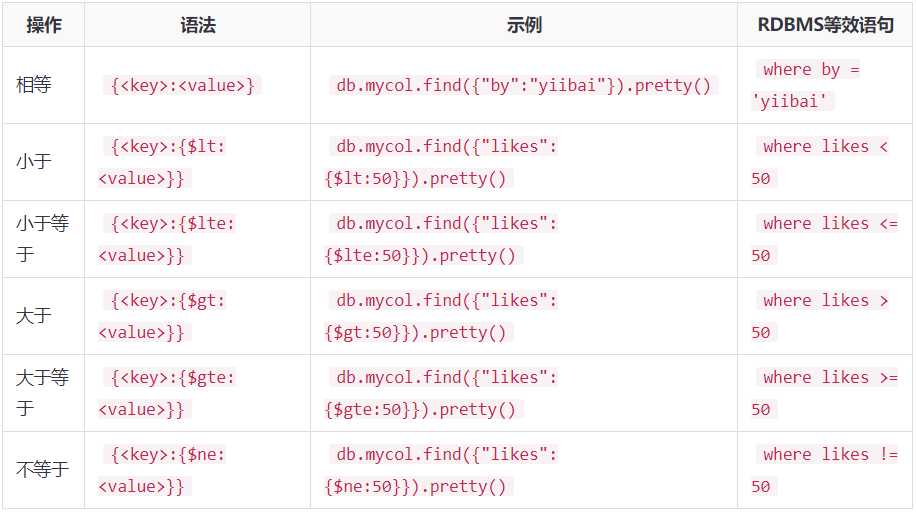MongoDB支持许多数据类型。
字符串 - 这是用于存储数据的最常用的数据类型。MongoDB中的字符串必须为UTF-8。
整型 - 此类型用于存储数值。 整数可以是32位或64位,具体取决于服务器。
布尔类型 - 此类型用于存储布尔值(true / false)值。
双精度浮点数 - 此类型用于存储浮点值。
最小/最大键 - 此类型用于将值与最小和最大BSON元素进行比较。
数组 - 此类型用于将数组或列表或多个值存储到一个键中。
时间戳 - ctimestamp,当文档被修改或添加时,可以方便地进行录制。
对象 - 此数据类型用于嵌入式文档。
对象 - 此数据类型用于嵌入式文档。
Null - 此类型用于存储Null值。
符号 - 该数据类型与字符串相同; 但是,通常保留用于使用特定符号类型的语言。
日期 - 此数据类型用于以UNIX时间格式存储当前日期或时间。您可以通过创建日期对象并将日,月,年的日期进行指定自己需要的日期时间。
对象ID - 此数据类型用于存储文档的ID。
二进制数据 - 此数据类型用于存储二进制数据。
代码 - 此数据类型用于将JavaScript代码存储到文档中。
正则表达式 - 此数据类型用于存储正则表达式。
2. 插入文档
2.1 insert()和save方法插入文档
引导数据插入到MongoDB集合中,需要使用MongoDB的insert()或save()方法。
语法:
>db.COLLECTION_NAME.insert(document)
例子:
>db.mycol.insert({ _id: 100, title: ‘MongoDB Overview‘, description: ‘MongoDB is no sql database‘, by: ‘yiibai tutorials‘, url: ‘http://www.yiibai.com‘, tags: [‘mongodb‘, ‘database‘, ‘NoSQL‘], likes: 100, })
这里 mycol的英文集合的名称,是在前一章创建的。如果数据库中不存在集合,则MongoDB将创建此集合,然后将文档插入到该集合中。
- 一个 4 字节的值,表示自 Unix 纪元以来的秒数
- 一个 3 字节的机器标识符
- 一个 2 字节的进程 ID
- 一个 3 字节的计数器,以随机值开始
_id: ObjectId(4 bytes timestamp, 3 bytes machine id, 2 bytes process id, 3 bytes incrementer)
要在单个查询中插入多个文档,可以在insert()命令中传递文档数组。如下所示:
> db.mycol.insert([ { _id: 101, title: ‘MongoDB Guide‘, description: ‘MongoDB is no sql database‘, by: ‘xhh tutorials‘, url: ‘http://www.baidu.com‘, tags: [‘mongodb‘, ‘database‘, ‘NoSQL‘], likes: 100 }, { _id: 102, title: ‘NoSQL Database‘, description: "NoSQL database doesn‘t have tables", by: ‘xhh tutorials‘, url: ‘http://www.baidu.com‘, tags: [‘mongodb‘, ‘database‘, ‘NoSQL‘], likes: 210, comments: [ { user:‘user1‘, message: ‘My first comment‘, dateCreated: new Date(2017,11,10,2,35), like: 0 } ] }, { _id: 104, title: ‘Python Quick Guide‘, description: "Python Quick start ", by: ‘xhh tutorials‘, url: ‘http://www.baidu.com‘, tags: [‘Python‘, ‘database‘, ‘NoSQL‘], likes: 30, comments: [ { user:‘user1‘, message: ‘My first comment‘, dateCreated: new Date(2018,11,10,2,35), like: 590 } ] } ])
2.2 其他插入文档的方法
2.2.1 db.collection.insertOne()方法
如果将文档_id分配给MongoDB,会自动将_id与其ObjectId值添加到新文档。
db.inventory.insertOne( { item: "canvas", qty: 100, tags: ["cotton"], size: { h: 28, w: 35.5, uom: "cm" } } )
方法返回包含新插入的文档的_id细分值的文档。
> db.inventory.insertOne( ... { item: "canvas", qty: 100, tags: ["cotton"], size: { h: 28, w: 35.5, uom: "cm" } } ... ) { "acknowledged" : true, "insertedId" : ObjectId("5955220846be576f199feb55") } >
2.2.2 db.collection.insertMany()方法
db.inventory.insertMany([ { item: "journal", qty: 25, tags: ["blank", "red"], size: { h: 14, w: 21, uom: "cm" } }, { item: "mat", qty: 85, tags: ["gray"], size: { h: 27.9, w: 35.5, uom: "cm" } }, { item: "mousepad", qty: 25, tags: ["gel", "blue"], size: { h: 19, w: 22.85, uom: "cm" } } ])
方法返回包含新插入的文档的_id细分值的文档。
> db.inventory.insertMany([ ... { item: "journal", qty: 25, tags: ["blank", "red"], size: { h: 14, w: 21, uom: "cm" } }, ... { item: "mat", qty: 85, tags: ["gray"], size: { h: 27.9, w: 35.5, uom: "cm" } }, ... { item: "mousepad", qty: 25, tags: ["gel", "blue"], size: { h: 19, w: 22.85, uom: "cm" } } ... ]) { "acknowledged" : true, "insertedIds" : [ ObjectId("59552c1c46be576f199feb56"), ObjectId("59552c1c46be576f199feb57"), ObjectId("59552c1c46be576f199feb58") ] } >
3. 查询文档
3.1 find()方法
要从MongoDB集合查询数据,需要使用MongoDB的find()方法。
语法:
>db.COLLECTION_NAME.find(document)
方法将以非结构化的方式显示所有文档。
3.2 pretty()方法
> db.mycol.find().pretty()
例子:
>db.mycol.find().pretty() { "_id": 100, "title": "MongoDB Overview", "description": "MongoDB is no sql database", "by": "yiibai tutorials", "url": "http://www.yiibai.com", "tags": ["mongodb", "database", "NoSQL"], "likes": "100" } >
除了find()方法外,还有一个findOne()方法,它只返回一个文档。
3.3 MongoDB与RDBMS的等效Where子句

3.4 MongoDB中的AND操作符
语法:
在find()方法中,如果通过‘,’将它们分开传递多个键,则MongoDB将其视为AND条件。
>db.mycol.find( { $and: [ {key1: value1}, {key2:value2} ] } ).pretty()
例子:
以下示例将显示由“xhh tutorials”编写并且标题为“MongoDB Overview”的所有教程。
> db.mycol.find({$and:[{"by":"xhh tutorials"},{"title": "MongoDB Overview"}]}).pretty() { "_id" : 100, "title" : "MongoDB Overview", "description" : "MongoDB is no sql database", "by" : "yiibai tutorials", "url" : "https://www.cnblogs.com/liuhui0308/", "tags" : [ "mongodb", "database", "NoSQL" ], "likes" : 100 }
对于上面给出的例子,等效的SQL where子句是:
SELECT * FROM mycol where by =‘yiibai tutorials‘ AND title =‘MongoDB Overview‘
可以在find子句中传递任意数量的键值。
3.5 MongoDB中的OR操作符
>db.mycol.find( { $or: [ {key1: value1}, {key2:value2} ] } ).pretty()
例子:
以下示例将显示由“xhh tutorials”编写并且标题为“MongoDB Overview”的所有教程。
>db.mycol.find({$or:[{"by":"xhh tutorials"},{"title": "MongoDB Overview"}]}).pretty() { "_id": 100, "title": "MongoDB Overview", "description": "MongoDB is no sql database", "by": "yiibai tutorials", "url": "https://www.cnblogs.com/liuhui0308/",
"tags": [
"mongodb",
"database",
"NoSQL"
],
"likes": "100"
}
>
3.6 AND和OR一起使用
10以及标题是“MongoDB”或者“xhh tutorials”的所有文档。SELECT * FROM mycol where likes> 10 AND(by =‘xhh tutorials‘ OR title =‘MongoDB Overview‘)
>db.mycol.find({"likes": {$gt:10}, $or: [{"by": "xhh tutorials"}, {"title": "MongoDB Overview"}]}).pretty() { "_id": 100, "title": "MongoDB Overview", "description": "MongoDB is no sql database", "by": "yiibai tutorials", "url": "https://www.cnblogs.com/liuhui0308/", "tags": ["mongodb", "database", "NoSQL"], "likes": "100" } >
3.7 查询嵌入/嵌套文档
db.collection.find()方法对嵌入/嵌套文档的查询操作的示例。 此页面上的示例使用inventory集合。要填充库存(inventory)集合以准备一些数据,请运行以下命令:db.inventory.insertMany( [ { item: "journal", qty: 25, size: { h: 14, w: 21, uom: "cm" }, status: "A" }, { item: "notebook", qty: 50, size: { h: 8.5, w: 11, uom: "in" }, status: "A" }, { item: "paper", qty: 100, size: { h: 8.5, w: 11, uom: "in" }, status: "D" }, { item: "planner", qty: 75, size: { h: 22.85, w: 30, uom: "cm" }, status: "D" }, { item: "postcard", qty: 45, size: { h: 10, w: 15.25, uom: "cm" }, status: "A" } ]);
3.7.1 匹配嵌入/嵌套文档
要在作为嵌入/嵌套文档的字段上指定相等条件,请使用查询过滤器文档{<field>:<value>},其中<value>是要匹配的文档。
例如,以下查询选择字段size等于{h:14,w:21,uom:"cm"}的所有文档:
db.inventory.find( { size: { h: 14, w: 21, uom: "cm" } } )
例如,以下查询与库存(
inventory)集合中的任何文档不匹配:db.inventory.find( { size: { w: 21, h: 14, uom: "cm" } } )
3.7.2 查询嵌套字段
要在嵌入/嵌套文档中的字段上指定查询条件,请使用点符号("field.nestedField")。
在嵌套字段上指定等于匹配
以下示例选择在size字段中嵌套的字段uom等于“in”的所有文档:
db.inventory.find( { "size.uom": "in" } )
3.7.3 使用查询运算符指定匹配
查询过滤器文档可以使用查询运算符来指定,如以下形式的条件:
{ <field1>: { <operator1>: <value1> }, ... }
以下查询使用size字段中嵌入的字段h中的小于运算符($lt):
db.inventory.find( { "size.h": { $lt: 15 } } )
3.7.4 指定AND条件
h小于15的所有文档,嵌套字段yom等于“in”,status字段等于“D”:db.inventory.find( { "size.h": { $lt: 15 }, "size.uom": "in", status: "D" } )
